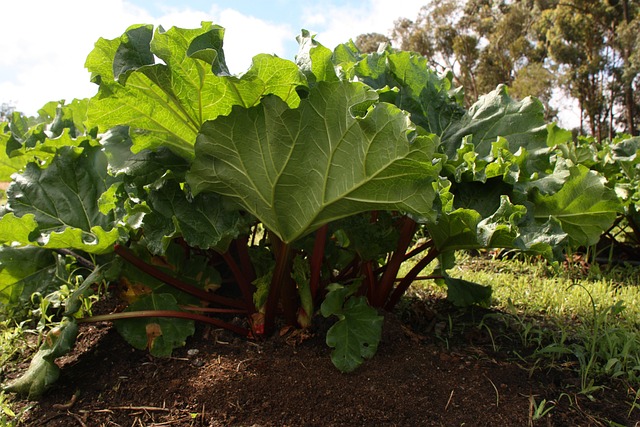Rhubarb isn’t one of the more popular items in the produce section, which probably means you are curious about it. If you haven’t tried rhubarb, you may have a million questions about it, which we seek to answer for you. So, what does rhubarb taste like? How can you utilize it in your kitchen?
What is Rhubarb?
Rhubarb has a bit of a complicated history. While it is technically a vegetable, rhubarb was legally made a fruit in the 1940s to save on import taxes and because it typically treated like a fruit.
Rhubarb looks like rosy-colored celery. While rhubarb is typically pink, it can also be a pale green, but the color doesn’t indicate its level or ripeness.
While rhubarb stalks are very obviously edible, the leaves of this plant are very dangerous. These poisonous leaves contain oxalic acid and anthraquinone glycosides, which can lead to a number of different symptoms. These symptoms include seizures, stomach pain, diarrhea, eye pain, kidney failure and coma. Death is possible, but rare.

What Does Rhubarb Taste Like?
Now for the important stuff: what does rhubarb taste like? Rhubarb has a very tart taste. Raw rhubarb is so tart that most people won’t eat it in that state. Think sour green apples, and you will get a good idea of what rhubarb tastes like. Generally, people cook or bake rhubarb and add sugar to make it taste sweeter.
Some people report a refreshing taste that is similar to celery, but it is hard to get past the tart flavor that rhubarb is so known for.
If the food world had best friends, the strawberry would be rhubarb’s best friend. You will find the two paired in the popular strawberry rhubarb pie, but they are also often baked together in other foods.
Health Benefits of Rhubarb
This fruit-vegetable hybrid contains a number of different vitamins and minerals that make it a great addition to your diet.
Rhubarb contains vitamins C and K, as well as B-complex vitamins. Dietary fiber, protein, calcium, manganese, magnesium and potassium, as well as lutein and beta-carotene, are all present in rhubarb, which makes it nutrient dense. It also has very few calories, and it is low in fat and cholesterol.
In addition to all these nutrients, rhubarb can help people lose weight, increase skin health and get better circulation. It can also help improve digestion, fuel bone growth and boost metabolism. The best part, however, is that rhubarb helps prevent Alzheimer’s disease and cancer, as well as a number of different cardiovascular problems.
How to Eat Rhubarb
Sugar is almost always added to rhubarb during the cooking process to make it a little more palatable. Like previously stated, the most popular way to eat rhubarb is in baked goods. Pies are the most common way rhubarb is prepared, and strawberries are a very common pairing with rhubarb.
One way we recommend trying rhubarb, just so you get a good idea of its natural taste, is to try to raw. Since it is a very tart fruit, you may want to dip it in sugar, honey, maple syrup or agave nectar to add a little sweetness. Trying it raw will allow you to better understand exactly what rhubarb tastes like, but if you don’t like it raw, don’t be afraid to give it another try.
Boiling rhubarb is another way to add sweetness to it. You can add dried fruits or fresh berries to the water to infuse sweetness into the rhubarb without adding a lot of sugar. Boiling rhubarb in fruit juice is another alternative.
Roasted rhubarb is a popular choice, because it is one of the easiest ways to prepare this fruit. Wash your rhubarb and pat it dry. After cutting the stalks into half-inch pieces, place them on a greased pan, sprinkle them with sugar and bake at 375° for 20 to 25 minutes.
Dried rhubarb is another option. You boil rhubarb in water, add sugar and a cinnamon stick and cook until you get an applesauce-like consistency. Pour the rhubarb onto a parchment-lined dehydrating tray and cook at 135° for 9 hours.
Pureed rhubarb can be used in a variety of different beverages. It is commonly added to smoothies, especially berry-based smoothies, and margaritas. You can also add champagne to pureed rhubarb for a new twist on a mimosa.
Sauces are a great way to incorporate rhubarb into your diet. It is easy to make a salsa or chutney that contains rhubarb. Plus, it works for a number of different foods like chicken, duck, pork, trout or turkey. You can also make rhubarb work in a variety of different cuisines.
In Conclusion
Now that we have answered the question, “what does rhubarb taste like,” we are ready to send you off to try rhubarb for yourself. You may want to consider trying rhubarb a number of different ways to see if you find a way that you enjoy it most.
If you have any further remarks or questions about what rhubarb tastes like, please leave us a comment below.
